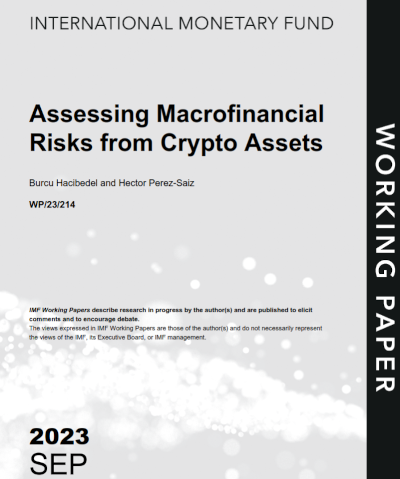Introduction
The world of cryptocurrencies and blockchain technology has been growing at an unprecedented pace in recent years. With the rise of decentralized finance (DeFi) and non-fungible tokens (NFTs), the crypto space has become more complex and interconnected than ever before. However, with this growth comes new risks and challenges that must be addressed by policymakers and industry leaders alike.
In this blog post, we will explore the key findings of the International Monetary Fund’s (IMF) report on “Assessing Macrofinancial Risks from Crypto Assets.” This report provides a comprehensive analysis of the systemic risks posed by crypto assets and offers a conceptual framework for understanding and tracking these risks.
The current state of the crypto market
IMF states the need for a comprehensive framework to assess the macrofinancial risks posed by crypto assets. The authors note that while the crypto market has grown significantly in recent years, there are still gaps in data and transparency that make it difficult to monitor and regulate the market effectively.
Main Actors, Risks, and Sectoral Linkages
The main actors in the crypto ecosystem are investors, exchanges, and miners. The authors also identify the main macro and micro risks associated with crypto assets, including market volatility, liquidity risk, and operational risk. Additionally, the chapter explores the sectoral linkages between the crypto market and the broader financial system, including the potential for contagion and spillover effects.


The C-RAM Framework
IMF introduces the C-RAM framework, which stands for Crypto-Asset Risk Assessment Matrix. This framework is designed to help policymakers and regulators assess the systemic risks posed by crypto assets and develop appropriate policy responses.
The C-RAM framework is based on existing risk assessment methodologies used in the financial sector, but has been adapted to account for the unique characteristics of crypto assets.
The C-RAM is a three-steps approach aims to incorporate macrofinancial crypto risks in country monitoring:
- The Decision Tree: assessing the macrocriticality of crypto assets in an economy.
- Country Risk Mapping: quantifying the crypto risks in an economy via country risk mapping
- Global Crypto Risk Assessment Matrix (C-RAM): a map of global risks for or from crypto assets with implications for macroeconomic stability and systemic risk
Applying the C-RAM Framework
The C-RAM framework has been applied to several country cases, including the United States, Japan, and South Korea. This framework has been used to assess the macrofinancial risks posed by crypto assets in each country and identify potential policy responses.
The chapter highlights the importance of data and transparency in assessing these risks and notes that effective regulation requires a coordinated effort across multiple jurisdictions.
Policy Challenges and Implications
The authors note that while the framework provides a useful tool for assessing systemic risks, there are still challenges associated with regulating the crypto market effectively. These challenges include the need for international coordination, the difficulty of regulating decentralized systems, and the potential for unintended consequences.
Key findings and recommendations
The authors note that while the crypto market has the potential to bring significant benefits, it also poses significant risks to the macrofinancial system. They emphasize the need for policymakers and industry leaders to work together to address these risks and develop appropriate policy responses.
The C-RAM framework provides a useful tool for assessing these risks and developing effective regulation.
Conclusion
The IMF’s report on “Assessing Macrofinancial Risks from Crypto Assets” provides a comprehensive analysis of the systemic risks posed by crypto assets and offers a useful framework for assessing these risks. The report highlights the importance of data and transparency in regulating the crypto market effectively and emphasizes the need for international coordination. As the crypto market continues to grow and evolve, it is essential that policymakers and industry leaders work together to address the risks and challenges posed by this emerging asset class.
By using the C-RAM framework, policymakers can better understand the risks associated with crypto assets and develop appropriate policy responses. However, the report also acknowledges that there are challenges associated with regulating the crypto market effectively, including the difficulty of regulating decentralized systems and the potential for unintended consequences.
One of the key takeaways from the report is the need for international coordination in regulating the crypto market. Given the global nature of the crypto market, it is essential that policymakers and regulators work together to develop a coordinated approach to regulation. This will require cooperation across multiple jurisdictions and the development of common standards and best practices.
Another important takeaway from the report is the need for greater transparency in the crypto market. The authors note that the lack of transparency in the market makes it difficult to assess the risks associated with crypto assets and develop appropriate policy responses. To address this issue, the report recommends that policymakers and industry leaders work together to improve data collection and reporting standards.
Overall, the IMF’s report on “Assessing Macrofinancial Risks from Crypto Assets” provides a valuable contribution to the ongoing debate around the regulation of the crypto market. By highlighting the risks associated with crypto assets and offering a framework for assessing these risks, the report provides a useful tool for policymakers and regulators. However, it is clear that there are still challenges associated with regulating the crypto market effectively, and it will require ongoing cooperation and collaboration to address these challenges.

Leave a Reply